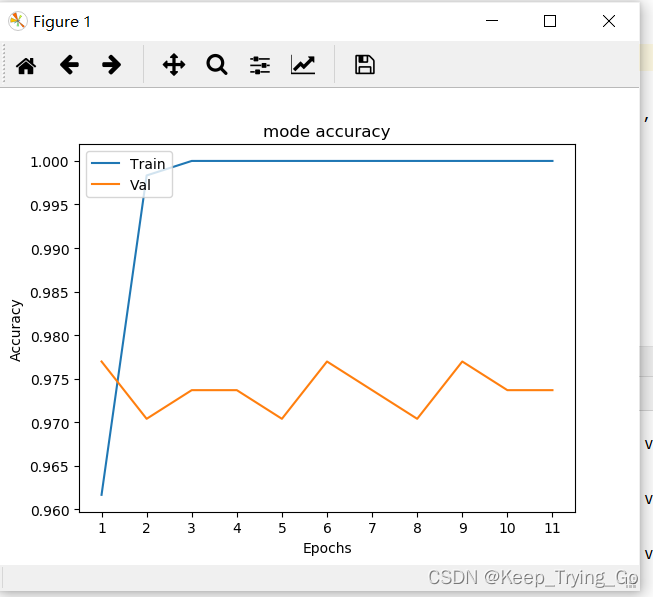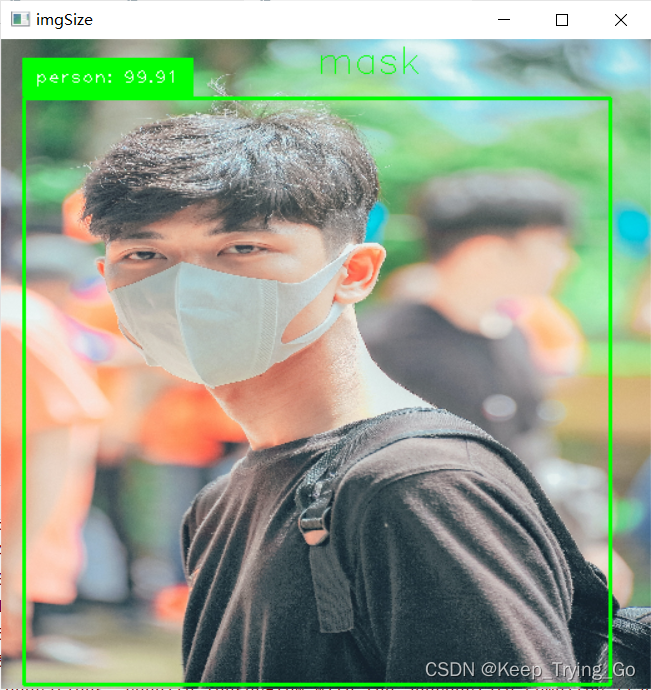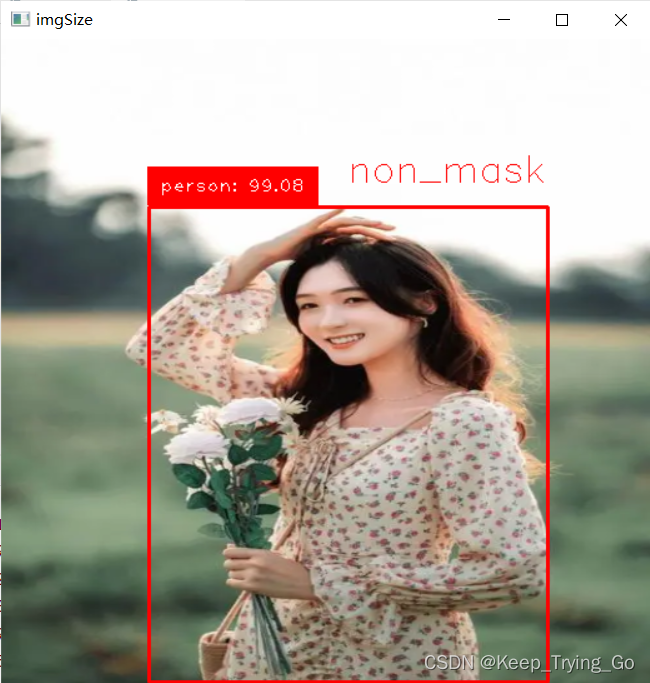目录
(2)使用MobileNet_SSD进行人脸定位进行口罩检测
1.数据集下载
下载方式一:
下载方式二:
链接:https://pan.baidu.com/s/1oMj7_0nvqm3vCoIWas-ygA
提取码:a7xu


2.相关知识点
-
预训练模型是一个之前基于大型数据集(通常是大型图像分类任务)训练的已保存网络。可以按原样使用预训练模型,也可以使用迁移学习针对给定任务自定义此模型。
-
用于图像分类的迁移学习背后的理念是,如果一个模型是基于足够大且通用的数据集训练的,那么该模型将有效地充当视觉世界的通用模型。随后,您可以利用这些学习到的特征映射,而不必通过基于大型数据集训练大型模型而从头开始。
-
通过以下两种方式来自定义预训练模型:
-
方式一:
- 特征提取:使用先前网络学习的表示从新样本中提取有意义的特征。您只需在预训练模型上添加一个将从头开始训练的新分类器,这样便可重复利用先前针对数据集学习的特征映射。
- 无需(重新)训练整个模型。基础卷积网络已经包含通常用于图片分类的特征。但是,预训练模型的最终分类部分特定于原始分类任务,随后特定于训练模型所使用的类集。
- 方式二:
- 微调:解冻已冻结模型库的一些顶层,并共同训练新添加的分类器层和基础模型的最后几层。这样,我们便能“微调”基础模型中的高阶特征表示,以使其与特定任务更相关。
-
-
通用的机器学习工作流。
- 检查并理解数据
- 构建输入流水线,在本例中使用 Keras ImageDataGenerator
- 构成模型
- 加载预训练的基础模型(和预训练权重)
- 将分类层堆叠在顶部
- 训练模型
- 评估模型
3.训练模型实战开始
(1)整个过程思路

(2)导入相关的库
import os
import cv2
import time
import numpy as np
import tensorflow as tf
from tensorflow import keras
from keras.models import Model
import matplotlib.pyplot as plt
from tensorflow.keras import layers
from tensorflow.keras.optimizers import Adam
from tensorflow.keras.models import load_model
from tensorflow.keras.preprocessing.image import ImageDataGenerator
from tensorflow.keras.callbacks import ModelCheckpoint,EarlyStopping,ReduceLROnPlateau
from tensorflow.keras.layers import Dense,Dropout,Flatten,BatchNormalization,Conv2D,MaxPool2D(3)参数预设置
#训练的类别:有口罩和无口罩
num_classes=2
#输入网路图片的大小
img_h,img_w=224,224
#训练一次性加载数据集大小
batch_size=4
#训练集和验证集图片位置
train_data_dir='myDataset/New Masks Dataset/Train'
validation_data_dir='myDataset/New Masks Dataset/Validation'(4)数据增强
#对图片数据进行增强
train_datagen=ImageDataGenerator(rescale=1.0/255)
val_datagen=ImageDataGenerator(rescale=1.0/255)
#对图片进行缩放大小,设置加载图片数量,定义类别模式和随机打散
train_generate=train_datagen.flow_from_directory(
train_data_dir,
target_size=(img_h,img_w),
batch_size=batch_size,
class_mode='categorical',
shuffle=True
)
val_generate=val_datagen.flow_from_directory(
validation_data_dir,
target_size=(img_h,img_w),
batch_size=batch_size,
class_mode='categorical',
shuffle=True
)(5)使用迁移学习搭建模型
#使用迁移学习的方式定义模型
model_inception_v3=keras.applications.inception_v3.InceptionV3(weights='imagenet',include_top=False)
x=model_inception_v3.output
x=keras.layers.GlobalAveragePooling2D()(x)
x=keras.layers.Dense(1024,activation='relu')(x)
predications=keras.layers.Dense(2,activation='softmax')(x)
model_V3=Model(inputs=model_inception_v3.input,outputs=predications)
#冻结住所有的层
for layer in model_inception_v3.layers:
layer.trainable=False
#查看模型
model_V3.summary()(6)定义相关的回调函数
#保存最优的模型
checkpoint=ModelCheckpoint(
'model/checkMask.h5',
monitor='val_loss',
mode='min',
save_best_only=True,
save_weights_only=False
)
#当经过5代之后,验证集的损失值没有下降就提前终止训练
earlyStop=EarlyStopping(
monitor='val_loss',
min_delta=0,
patience=10,
verbose=1,
restore_best_weights=True
)
#当经过3代的训练之后验证集的损失值没有下降就学习衰减率
reduce_lr=ReduceLROnPlateau(
monitor='val_loss',
factor=0.8,
patience=10,
verbose=1,
min_delta=0.0001
)
callbacks=[checkpoint,earlyStop,reduce_lr](7)模型训练
#模型编译
model_V3.compile(loss='categorical_crossentropy',optimizer=Adam(learning_rate=0.0001),
metrics=['accuracy'])
#获取训练集和验证集大小
n_train=train_generate.n
n_val=val_generate.n
#迭代次数
epoches=50
#开始训练
history=model_V3.fit(
train_generate,
steps_per_epoch=n_train//batch_size,
callbacks=callbacks,
epochs=epoches,
validation_data=val_generate,
validation_steps=n_val//batch_size
)
(8)绘制图形
#绘制图像
x=range(1,len(history.history['accuracy'])+1)
plt.plot(x,history.history['accuracy'])
plt.plot(x,history.history['val_accuracy'])
plt.title('mode accuracy')
plt.ylabel('Accuracy')
plt.xlabel('Epochs')
plt.xticks(x)
plt.legend(['Train','Val'],loc='upper left')
plt.savefig(fname='inception_v3',figsize=[10,10])
plt.show()

4.口罩检测开始
首先理解使用MobileNet_SSD进行目标检测过程:
(1)结合训练的模型进行预测
detect.py
import os
import cv2
import numpy as np
from PIL import Image
import tensorflow as tf
from tensorflow.keras.models import load_model
from MobileSSD300x300 import detectTime,SignalDetect,processImage
from tensorflow.keras.preprocessing.image import img_to_array,load_img
#训练模型的位置
modelPath='model/checkMask.h5'
#输入网络的图片大小
target_size=(224,224)
#预测图片位置
imgPath='myDataset/New Masks Dataset/Test/Mask/2072.jpg'
#图片的预测类别
classes={0:'mask',1:'non_mask'}
#对图像进行预处理
def preprocess_image(img_path,target_size):
"""
:param img_path: 图片路径
:param target_size: 图片大小
:return:
"""
image=Image.open(img_path)
if image.mode!='RGB':
image=image.convert('RGB')
image=image.resize(target_size)
image=img_to_array(image)
image=image/255.0
image=np.expand_dims(image,axis=0)
return image
#单张图片检测
def detectImage(imgPath):
modelInV3 = load_model(modelPath)
img = preprocess_image(img_path=imgPath, target_size=target_size)
predications = modelInV3.predict(img)[0].tolist()
print(predications)
print(np.argmax(predications))
PreResult = int(np.argmax(predications))
print('预测类别: {}'.format(classes[PreResult]))
imgSize = cv2.imread(imgPath)
imgSize = cv2.resize(src=imgSize, dsize=(520, 520))
imgSize = cv2.flip(src=imgSize, flipCode=2)
imgSize = processImage(imgSize=imgSize,mask=classes[PreResult])
print(np.shape(imgSize))
cv2.imshow('imgSize', imgSize)
cv2.waitKey(0)
cv2.destroyAllWindows()
#实时检测
def Timedetect():
modelInV3 = load_model(modelPath)
detectTime(modelInV3=modelInV3,classes=classes)
if __name__ == '__main__':
# Timedetect()
detectImage(imgPath=imgPath)(2)使用MobileNet_SSD进行人脸定位进行口罩检测
MobileSSD300x300.py
"""
@Author : Keep_Trying_Go
@Major : Computer Science and Technology
@Hobby : Computer Vision
@Time : 2023-01-01 17:40
"""
import os
import cv2
import cvzone
import numpy as np
from PIL import Image
from tensorflow.keras.models import load_model
from tensorflow.keras.preprocessing.image import img_to_array
#设置图片的宽高
img_w,img_h=300,300
#得到图片的高宽比
WHRatio=img_w/float(img_h)
#设置图片的缩放因子
ScaleFactor=0.007843
#设置平均值
meanVal=127.5
#设置置信度阈值
threadVal=0.2
#预测类别
#mobileNetSSD可以检测类别数21=20+1(背景)
classNames = ['background',
'aeroplane', 'bicycle', 'bird', 'boat',
'bottle', 'bus', 'car', 'cat', 'chair',
'cow', 'diningtable', 'dog', 'horse',
'motorbike', 'person', 'pottedplant',
'sheep', 'sofa', 'train', 'tvmonitor']
#加载文件
net=cv2.dnn.readNetFromCaffe(prototxt='SSD300X300/MobileNetSSD_300x300.prototxt',
caffeModel='SSD300X300/mobilenet_iter_73000.caffemodel')
#对图片进行处理和设置网络的输入同时进行前向传播
def processImage(imgSize,mask):
# 对图片进行预处理
blob = cv2.dnn.blobFromImage(image=imgSize, scalefactor=ScaleFactor,
size=(img_w, img_h), mean=meanVal)
# 设置网络的输入并进行前向传播
net.setInput(blob)
detections = net.forward()
# 对图像进行按比例裁剪
height,width,channel=np.shape(imgSize)
if width/float(height)>WHRatio:#说明高度比较小
#裁剪多余的宽度
cropSize=(int(height*WHRatio),height)
else:#说明宽度比较小
# 裁剪多余的高度
cropSize = (width,int(width / WHRatio))
x1 = int((width - cropSize[0]) / 2)
x2 = int(x1 + cropSize[0])
y1=int((height-cropSize[1])/2)
y2=int(y1+cropSize[1])
imgSize=imgSize[y1:y2,x1:x2]
height,width,channel=np.shape(imgSize)
#遍历检测的目标
# print('detection.shape: {}'.format(detections.shape))
# print('detection: {}'.format(detections))
for i in range(detections.shape[2]):
#保留两位小数
confidence=round(detections[0,0,i,2]*100,2)
#这里只检测人这个目标
if confidence>threadVal:
class_id=int(detections[0,0,i,1])
if class_id==15:
xLeftBottom=int(detections[0,0,i,3]*width)
yLeftBottom=int(detections[0,0,i,4]*height)
xRightTop=int(detections[0,0,i,5]*width)
yRightTop=int(detections[0,0,i,6]*height)
# 绘制是否佩戴口罩标志的位置
mask_x = int(xLeftBottom + (xRightTop - xLeftBottom) / 2)
mask_y = int(yLeftBottom - 20)
if mask=='mask':
cv2.rectangle(img=imgSize,pt1=(xLeftBottom,yLeftBottom),
pt2=(xRightTop,yRightTop),color=(0,255,0),thickness=2)
label=classNames[class_id]+": "+str(confidence)
labelSize, baseLine = cv2.getTextSize(label, cv2.FONT_HERSHEY_SIMPLEX, 0.5, 1)
cvzone.putTextRect(img=imgSize,text=label,pos=(xLeftBottom+9,yLeftBottom-12),
scale=1,thickness=1,colorR=(0,255,0))
cv2.putText(imgSize, str(mask), (mask_x, mask_y),
cv2.FONT_HERSHEY_SIMPLEX, 1.0, (0, 255, 0))
elif mask=='non_mask':
cv2.rectangle(img=imgSize, pt1=(xLeftBottom, yLeftBottom),
pt2=(xRightTop, yRightTop), color=(0, 0, 255), thickness=2)
label = classNames[class_id] + ": " + str(confidence)
labelSize, baseLine = cv2.getTextSize(label, cv2.FONT_HERSHEY_SIMPLEX, 0.5, 1)
cvzone.putTextRect(img=imgSize, text=label, pos=(xLeftBottom + 9, yLeftBottom - 12),
scale=1, thickness=1, colorR=(0, 0, 255))
# cv2.rectangle(imgSize, (xLeftBottom, yLeftBottom - labelSize[1]),
# (xLeftBottom + labelSize[0], yLeftBottom + baseLine),
# (255, 255, 255), cv2.FILLED)
cv2.putText(imgSize, str(mask), (mask_x, mask_y),
cv2.FONT_HERSHEY_SIMPLEX, 1.0, (0, 0, 255))
return imgSize
#对单张图片进行检测
def SignalDetect(img_path='images//8.png'):
imgSize=cv2.imread(img_path)
imgSize=processImage(imgSize=imgSize,mask='mask')
cv2.imshow('imgSize', imgSize)
cv2.waitKey(0)
cv2.destroyAllWindows()
#输入网络的图片大小
target_size=(224,224)
#对图像进行预处理
def preprocess_image(image,target_size):
"""
:param img_path: 图片路径
:param target_size: 图片大小
:return:
"""
image=Image.fromarray(image,mode='RGB')
if image.mode!='RGB':
image=image.convert('RGB')
image=image.resize(target_size)
image=img_to_array(image)
image=image/255.0
image=np.expand_dims(image,axis=0)
return image
#实时检测
def detectTime(modelInV3,classes):
cap=cv2.VideoCapture(0)
while cap.isOpened():
ret,frame=cap.read()
#预测图像类别
img=preprocess_image(frame,target_size=target_size)
predications = modelInV3.predict(img)[0].tolist()
print(predications)
print(np.argmax(predications))
PreResult = int(np.argmax(predications))
print('预测类别: {}'.format(classes[PreResult]))
frame=cv2.resize(src=frame,dsize=(520,520))
frame=cv2.flip(src=frame,flipCode=2)
frame=processImage(frame,mask=classes[PreResult])
cv2.imshow('frame',frame)
key=cv2.waitKey(1)
if key==27:
break
cap.release()
cv2.destroyAllWindows()
if __name__ == '__main__':
SignalDetect()
提示:这里检测是在detect.py文件中,而关于MobileSSD300x300.py文件则是实现相关的人脸检测,所以在detect.py中需要导入MobileSSD300x300.py文件,如下:
from MobileSSD300x300 import detectTime

